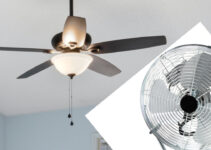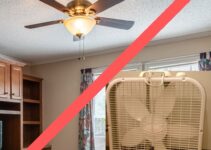Why Your Ceiling Fan Might Be Shaking
You’ve probably noticed that sometimes your ceiling fan starts shaking when you crank it up to high speed. It can be annoying but don’t worry; there are a few common reasons for this issue. First off, it could be that your fan blades are out of balance. This happens when one or more of the blades is slightly heavier or lighter than the others, causing the whole thing to wobble.
Another possible cause is loose screws or connections. Over time, the screws that hold your fan together can loosen, leading to a shaky fan. Finally, it’s possible that your fan’s motor is wearing out, which can also cause some unsteadiness.
Balancing Your Fan Blades
If you suspect that your fan blades are out of balance, there’s a pretty simple fix you can try. First, grab a ruler or a tape measure and measure the distance from the tip of each blade to the ceiling. If you find that one or more of the blades is a bit off, you can use a blade balancing kit to fix it. These kits usually come with small adhesive weights that you can attach to the blades to even out the weight distribution. Once you’ve got the blades balanced, your fan should stop shaking at high speed.
Tightening Loose Screws and Connections
Another thing you can do to stop your ceiling fan from shaking is to make sure all the screws and connections are nice and tight. You’ll want to grab a screwdriver and start by checking the screws that hold the blades to the brackets. If you find any that are loose, go ahead and tighten them up. Next, check the screws that connect the brackets to the motor, as well as any other screws or connections on the fan. By making sure everything is secure, you can help eliminate any wobbling issues.
Checking the Motor
If you’ve tried balancing the blades and tightening the screws, but your fan is still shaking, it might be time to take a look at the motor. If the motor is starting to wear out, it could be causing your fan to shake at high speed. Unfortunately, there’s not much you can do to fix a worn-out motor, so your best bet might be to replace the fan entirely. On the bright side, new ceiling fans can be more energy-efficient and have updated features, so it might be a good opportunity to upgrade.
Proper Installation and Maintenance
One way to prevent your ceiling fan from shaking in the first place is to make sure it’s installed correctly. When you’re putting up a new fan, be sure to follow the manufacturer’s instructions to the letter, and don’t be afraid to call in a professional if you’re unsure about anything. Proper installation can go a long way toward keeping your fan running smoothly.
Additionally, it’s important to perform regular maintenance on your ceiling fan. This includes cleaning the blades, checking for loose screws, and even checking the balance every once in a while. By keeping up with maintenance, you can help ensure that your fan stays steady, even at high speed.
Alternative Solutions and Considerations
If you’ve tried everything and your fan still shakes at high speed, it might be time to consider some alternative solutions. You could try using a lower speed setting if the shaking isn’t as noticeable at lower speeds. Additionally, you could look into installing a fan with a DC motor, which tends to run more smoothly and quietly than traditional AC motors.
In some cases, you might just have to accept that your fan is going to shake a little at high speed. Keep in mind that a small amount of wobble is normal for most ceiling fans, and as long as it’s not causing any safety concerns, you can probably live with it.
Upgrading to a High-Quality Ceiling Fan
If you’ve exhausted all other options and are still dealing with a shaky ceiling fan at high speed, it might be time to consider investing in a higher-quality fan. While it’s true that you get what you pay for, opting for a well-known, reputable brand can make a significant difference in terms of performance and longevity. These fans are typically designed with better materials, more precise engineering, and higher-quality motors, which can result in a smoother and more stable operation.
Before making a purchase, take the time to read reviews and research different brands and models to find a ceiling fan that has a reputation for being stable and reliable, even at high speeds. Keep in mind that factors like blade size, blade pitch, and motor quality can all play a role in how well a fan performs, so be sure to consider these aspects when making your decision.
The Importance of Professional Installation
While it’s possible to install a ceiling fan yourself, if you’re not confident in your abilities or if you’re dealing with an unusually high or difficult-to-reach ceiling, it’s worth considering hiring a professional to handle the installation. A qualified electrician or experienced installer will have the necessary tools and expertise to ensure that your new fan is installed correctly and securely, which can help prevent issues like shaking and wobbling down the line.
Even if you’re confident in your DIY skills, it’s still a good idea to consult the manufacturer’s instructions and guidelines when installing a new fan, as there may be specific requirements or steps that are unique to that particular model. Taking the time to do it right can save you a lot of headaches in the long run.
Ceiling Fan Safety Tips

No matter what kind of ceiling fan you have, it’s important to keep safety in mind. Here are a few tips to help ensure that your fan remains secure and operates as it should:
- Regularly check for loose screws or connections and tighten them as needed.
- Clean your fan blades and motor housing periodically to prevent dust and debris from building up and affecting performance.
- Make sure your fan is securely mounted to the ceiling and that the electrical connections are properly installed and maintained.
- If you have any concerns about your fan’s stability or safety, consult a professional for advice or assistance.
By following these tips and addressing any issues as soon as they arise, you can help keep your ceiling fan running smoothly and safely, even at high speed. And remember, a little bit of maintenance can go a long way in preventing problems like shaking and wobbling, so don’t neglect your fan.
FAQ 1: Can a shaking ceiling fan be dangerous?
Answer: Yes, a shaking ceiling fan can potentially be dangerous if the issue is not addressed. Excessive wobbling can cause the fan to become unstable, increasing the risk of the fan or its components falling from the ceiling. It’s essential to identify the cause of the shaking and fix it as soon as possible to ensure the safety of everyone in the room.
FAQ 2: How often should I check my ceiling fan for loose screws or balance issues?
Answer: It’s a good idea to inspect your ceiling fan for loose screws or balance issues at least twice a year. Regular checks can help you catch any issues early on and prevent more significant problems down the line. Additionally, it’s wise to perform a quick inspection if you notice any unusual sounds or shaking from your fan.
FAQ 3: Can the type of ceiling fan mount affect its stability?
Answer: Yes, the type of ceiling fan mount can have an impact on its stability. Flush mounts are generally more stable than downrod mounts, as they’re installed directly onto the ceiling. However, downrod mounts can provide better airflow and are necessary for rooms with high or sloped ceilings. When choosing a ceiling fan mount, make sure to follow the manufacturer’s recommendations for the best results.
FAQ 4: Is it normal for a brand-new ceiling fan to shake at high speed?
Answer: While a small amount of wobble is normal for most ceiling fans, excessive shaking at high speed is not typical for a brand-new fan. If you’ve just installed a new fan and are experiencing significant wobbling, double-check the installation to ensure everything is secure and properly aligned. If the issue persists, contact the manufacturer for assistance or consider returning the fan for a replacement.
FAQ 5: Can I use a regular light dimmer switch to control my ceiling fan speed?
Answer: No, you should not use a regular light dimmer switch to control your ceiling fan speed. Dimmer switches are designed to control the flow of electricity to a light bulb, whereas ceiling fans require a specific type of control to adjust their speed properly. Using a dimmer switch on a ceiling fan can cause the motor to overheat and potentially damage the fan. Instead, use a fan speed control switch or a remote control specifically designed for ceiling fans.





